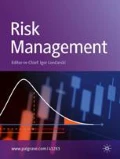Abstract
Recent crises have implicated organizational networks, rather than individual, unitary organizations, suggesting that the network rather than the single organization is the appropriate unit of analysis for understanding risk. It is the division of labour across organizational boundaries that appear to be especially threatening. This study investigated how sense is made of the risk that arises from this division of labour, analysing journalistic commentary on two iconic cases in the UK: the Hatfield derailment and the Sudan 1 food contamination scandal. In both cases it was the nature of networks that was central to most explanations of the events that took place, and in both cases it was the societal perception of risk that was more consequential than the objective physical harm. The main conclusion from the analysis was that this sensemaking was ambivalent about organizational networks – seeing advantages as well as drawbacks, and indicating that the main problem was not the choice of how to divide labour but to ensure that the chosen division was rigorously developed and maintained.


Similar content being viewed by others
References
Antaki, C. (1988). Explanations, Communication and Social Cognition. In Antaki, C. (ed.) Analysing Everyday Explanation: A Casebook of Methods. London: Sage, pp 1–14.
Beck, U. (1992). Risk Society: Towards a New Modernity. London: Sage.
Borgatti, S.P. and Foster, P.C. (2003). The Network Paradigm in Organizational Research: A Review and Typology. Journal of Management. Vol. 29, pp 991–1013.
Eisenhardt, K.M. (1989). Building Theories From Case Study Research. Academy of Management Review. Vol. 14, pp 532–550.
Freudenberg, W.R. (1993). Risk and Recreancy: Weber, the Division of Labour, and the Rationality of Risk Perceptions. Social Forces. Vol. 71, pp 909–932.
Freudenberg, W.R. (2003). Institutional Failure and The Organizational Amplification of Risk: The Need for a Closer Look. In Pidgeon, N., Kasperson, R. and Slovic, P. (eds) The Social Amplification of Risk. Cambridge, UK: Cambridge University Press, pp 102–120.
Fulk, J. (2001). Global Network Organizations: Emergence and Future Prospects. Human Relations. Vol. 54, pp 91–99.
Gephart jr., R.P. (1993). The Textual Approach: Risk and Blame in Disaster Sensemaking. Academy of Management Journal. Vol. 36, pp 1465–1514.
Gibson, S. (2005). Incentivising Operational Performance on the UK Rail Infrastructure since 1996. Utilities Policy. Vol. 13, pp 222–229.
Grabowski, M. and Roberts, K.H. (1999). Risk Mitigation in Virtual Organizations. Organization Science. Vol. 10, pp 704–721.
Granovetter, M. (1985). Economic Action and Social Structure: The Problem of Embeddedness. American Journal of Sociology. Vol. 91, pp 481–510.
Hale, A., Heijer, T. and Koornneef, F. (2003). Management of Safety Rules: The Case of Railways. Safety Science Monitor. Vol. 1, No. 3, pp 1–11.
HSE (2001). Train derailment at Hatfield – 17 October 2000. Second HSE interim report, Health and Safety Executive. Accessed 2 February 2006 at http://www.hse.gov.uk/railways/hatfield/interim2.htm.
Hutter, B. and Power, M. (2005). Organizational Encounters with Risk: An Introduction. In Hutter, B. and Power, M. (eds) Organizational Encounters with Risk. Cambridge UK: Cambridge University Press, pp 1–32.
Jasanoff, S. (1993). Bridging the Two Cultures of Risk Analysis. Risk Analysis. Vol. 13, pp 123–129.
Jones, C., Hesterly, W.S. and Borgatti, S.P. (1997). A General Theory of Network Governance: Exchange Conditions and Social Mechanisms. Academy of Management Review. Vol. 22, pp 911–945.
La Porte, T.R. (1996). High Reliability Organizations: Unlikely, Demanding and at Risk. Journal of Contingencies and Crisis Management. Vol. 4, pp 60–71.
La Porte, T.R. and Thomas, C.W. (1995). Regulatory Compliance and the Ethos of Quality Enhancement: Surprises in Nuclear Power Plant Operations. Journal of Public Administration Research and Theory. Vol. 5, pp 109–137.
Luhmann, N. (1993). Risk: A Sociological Theory. Berlin: Walter de Gruyter.
Miles, R.E. and Snow, C.C. (1992). Causes of Failure in Network Organizations. California Management Review. Vol. 34, pp 52–75.
Podolny, J.M. and Page, K.L. (1998). Network Forms of Organization. Annual Review of Sociology. Vol. 24, pp 57–76.
Powell, W.W. (1990). Neither Market nor Hierarchy: Network Forms of Organization. In Staw, B.M. and Cummings, L.L. (eds) Research in Organizational Behavior Volume 12. Greenwich, CT: JAI Press, pp 295–336.
Provan, K.G. and Milward, H.B. (1995). A Preliminary Theory of Interorganizational Network Effectiveness: A Comparative Study of Four Community Mental Health Systems. Administrative Science Quarterly. Vol. 40, pp 1–33.
Ramanujam, R. and Goodman, P.S. (2003). Latent Errors and Adverse Organizational Consequences: A Conceptualization. Journal of Organizational Behavior. Vol. 24, pp 815–836.
Rasmussen, J. (1997). Risk Management in a Dynamic Society: A Modelling Problem. Safety Science. Vol. 27, pp 183–213.
Reason, J. (1990). The Contribution of Latent Human Failures to the Breakdown of Complex Systems. Philosophical Transactions of the Royal Society. B, Vol. 327, pp 475–484.
Roberts, K. (1990). Some Characteristics of One Type of High Reliability Organization. Organization Science. Vol. 1, pp 160–176.
Salancik, G.R. (1995). Wanted: A Good Network Theory of Organization. Administrative Science Quarterly. Vol. 40, pp 345–349.
Schulman, P.R. (1993). The Negotiated Order of Organizational Reliability. Administration and Society. Vol. 25, pp 353–372.
Snook, S.A. (2000). Friendly Fire: The Accidental Shootdown of US Black Hawks Over Northern Iraq. Princeton, NJ: Princeton University Press.
Stake, R.E. (1995). The Art of Case Study Research. Thousand Oaks, CA: Sage.
Stubbs, M. (1983). Discourse Analysis: The Sociolinguistic Analysis of Natural Language. Oxford, UK: Blackwell.
Sydow, J. and Windeler, A. (1998). Organizing and Evaluating Interfirm Networks: A Structurationist Perspective on Network Processes and Effectiveness. Organization Science. Vol. 9, pp 265–284.
Turner, B.A. (1978). Man-Made Disasters. London: Wykeham.
Uzzi, B. (1997). Networks and the Paradox of Embeddedness. Administrative Science Quarterly. Vol. 42, pp 35–67.
Weick, K.E. (1987). Organizational Culture as a Source of High Reliability. California Management Review. Vol. 29, pp 112–127.
Weick, K.E. and Roberts, K.H. (1993). Collective Mind in Organizations: Heedful Interrelating on Flight Decks. Administrative Science Quarterly. Vol. 38, pp 357–381.
Yin, R.K. (2003). Case Study Research: Design and Methods, 3rd edn. Thousand Oaks, CA: Sage.
Author information
Authors and Affiliations
Rights and permissions
About this article
Cite this article
Busby, J., Alcock, R. Risk and Organizational Networks: Making Sense of Failure in the Division of Labour. Risk Manag 10, 235–256 (2008). https://doi.org/10.1057/rm.2008.10
Published:
Issue Date:
DOI: https://doi.org/10.1057/rm.2008.10




